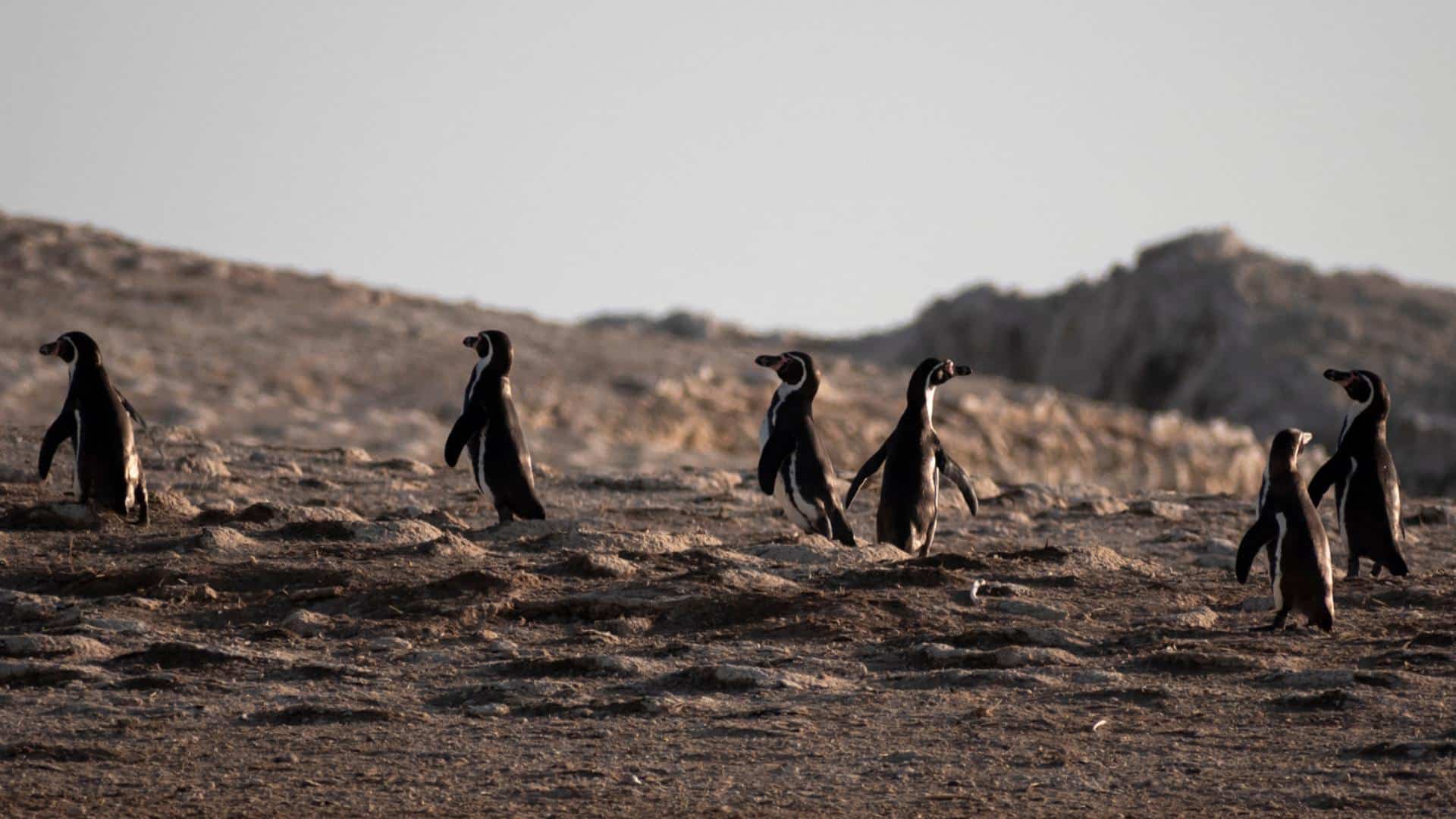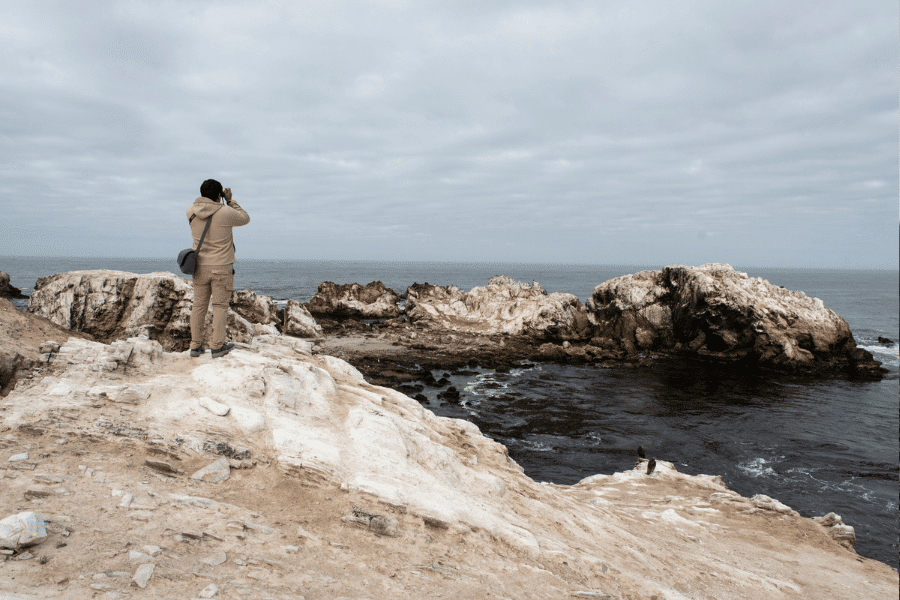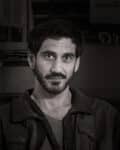Wildlife researchers in Peru are working to help boobies, pelicans, sea lions and other animals to not just survive, but thrive.

A group of Humboldt penguins returning to their nests in Punta San Juan, Peru. (Photo by Alfonso Silva-Santisteban)
This article was produced exclusively for News Decoder’s global news service. It is through articles like this that News Decoder strives to provide context to complex global events and issues and teach global awareness through the lens of journalism. Learn how you can incorporate our resources and services into your classroom or educational program.
When Susana Cárdenas saw the first dead pelican in Punta San Juan, Peru at the end of November 2022, the biologist had no clear idea of what was to come.
Eleven days earlier, the government had reported the first cases of avian flu, more than a thousand kilometers north on the Peruvian coast. The pandemic had reached the reserve.
“The proximity of so many species was perfect and it passed to mammals,” Cárdenas said.
Within weeks, the warm waters of the El Niño current displaced the anchovies that feed the wildlife. “We’ve never had a combination of avian flu and El Niño,” she said. “That didn’t give them time to recover.”
In September 2022, the Ministry of the Environment in Peru estimated that there were 200,000 guanay cormorants in Punta San Juan. A year later, the estimation was fewer than 100. Pelicans went from 4,000 to four, eared seals from 7,000 to 1,300 and penguins were nowhere to be seen. Cárdenas, whose focus is on science and advocacy, was dealing with one of her biggest challenges as a conservationist.
A natural laboratory
Punta San Juan is a peninsula of 54 hectares (133 acres) eight hours south of Lima by bus. Its base is enclosed by a wall built in the 1940s to repopulate it with guanay cormorants, boobies and pelicans — the guano birds of Peru — after guano was extracted almost entirely during its boom. In the late 19th and early 20th centuries, guano was a highly valuable commodity worldwide used as fertilizer.
The wall caused guano birds, penguins and eared seals to multiply exponentially, turning San Juan into a natural laboratory.
In 1979, Patricia Majluf, then a biology student, started studying eared seals at San Juan. Two species coexist without competing for food on the peninsula: the South American fur seal (Arctocephalus australis) and sea lions (Otaria flavescens).

A colony of South American fur seals resting at a beach. (Photo: Alfonso Silva-Santisteban)
In Spanish, they are known as the “fine” and “common” sea lions (lobo fino y lobo chusco), because of their type of fur that led them to be hunted for clothing decades ago.
Majluf is now one of the most respected marine biologists in the region, whose work led to the creation of a Punta San Juan Program. In 2009, the Peruvian government declared San Juan a natural protected area. Cárdenas arrived as Majluf’s student in 2004. Today, she is a professor at the Universidad Peruana Cayetano Heredia and directs the program.
“You are the biologist behind the wall, you live and die there,” she said.
A sea wall protects sea life.

Kevin Farfán during a daily monitor round. (Photo by Alfonso Silva-Santisteban)
Kevin Farfán puts on his windbreaker, hangs up his binoculars and camera and begins his daily monitoring round at 6:30 a.m. He started as an intern seven years ago and now coordinates the station. He walks by San Juan’s 20 beaches, while Odeth Perez, who is on her way to an observation post, says hello from afar.
All year round, at least two people at the station observe animal behavior, count species with drones and camera traps and monitor sea and air temperatures. Once a year, with the help of U.S. veterinarians, they capture and tag a sample of eared seals and penguins to attach transmitters and study their movements.
“We have 40 years of data,” Cárdenas said.
Since 2013, the team has crossed the wall separating the peninsula to connect with the residents of Marcona, a neighboring town founded in the 1950s after the discovery of an iron deposit.
They began with guided tours. Since 2023, they have initiated a project called Natural Classrooms with students from local schools, serving a town with 15,000 inhabitants.
Biologist Ximena Turcke is one of the guides. “It is important to reach the children, especially the younger ones,” Turcke said. On this day, she was leading a group of 30 students from Miguel Grau School to one of the viewpoints and later, to a neighboring beach for group work. “I’ve always liked people to identify with their place, wherever they go,” she said.
Recovery and threats
The most important thing to remember when walking in San Juan is not to disturb the animals. The eared seal breeding season starts in October and peaks between January and February.
A group of 1,500 guanay cormorants arrived in October 2024. Before the avian flu in 2022, there were so many that they sometimes blocked the entrance to the team’s observation booth.
Cárdenas said that there are few places where so many different animals with breeding colonies come together and that’s why the virus spread so quickly.
Avian influenza AH5N1 is a subtype that affects birds and mammals, including humans in rare cases. The virus emerged in China in 1996 and has caused sporadic outbreaks. However, in 2020, a more transmissible variant of the virus passed from poultry to wild birds and began migrating worldwide. It reached North America in 2021 and South America in 2022. The flu spread from Peru to Chile, Argentina and Uruguay, affecting sea birds and mammals. There were no human cases.
When Cárdenas arrived in San Juan, wildlife was recovering from the 1998 El Niño phenomenon and she saw how animals adapt to cycles when food is scarce. That’s why she remains optimistic about the repopulation of San Juan. But it will take several years and human activity must not alter the conditions for recovery.
“There’s an incredible resilience,” she said.
Limits on fishing
One of the main threats is fishing. Industrial fishing takes almost 9 out of 10 anchovetas from the Peruvian sea to make fishmeal. Four tons of anchoveta produce one ton of fishmeal, which is mainly used to feed salmon, pigs or chickens in industrial farms around the world.
Year after year, there are tensions between the fishing industry, the state and environmentalists over fishing quotas or minimum sizes of anchovies that can be caught. The Institute of the Peruvian Sea, the national scientific organization concerning the sustainability of marine resources, is part of the Ministry of Production.
The conflict of interest is evident for Cárdenas, whose team has observed, by analyzing the feces of eared seals, that these are feeding more and more on smaller fish with less nutritional value. They are consuming what ecologists have called marine ecosystems’ junk food.
In 2023, the state suspended the first industrial fishing season due to El Niño but reinstated the second one. It was too soon for Cárdenas and Farfán. They oppose the industry’s approach of expanding fishing almost indefinitely without consequences. “There have been no lessons learned from all this,” Cárdenas said. “It’s when these things happen that conservancy is most urgent.”
Three questions to consider:
1. How does fishing affect sea life?
2. How are researchers working to help the sea life at Punta San Juan?
3. What, if anything, can you do to help wildlife near you?

Alfonso Silva-Santisteban is a a public health physician and freelance journalist based in Lima, Peru. He is the director of the Center for Interdisciplinary Research on Sexuality, AIDS and Society at Universidad Peruana Cayetano Heredia. His work focuses on human rights, gender issues and community organizing.
